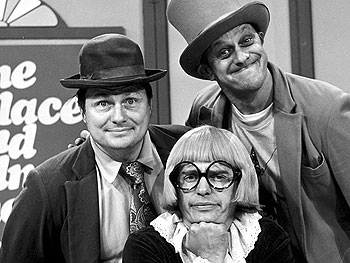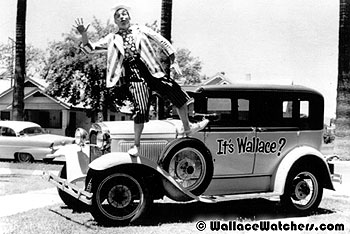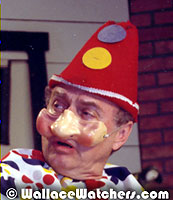A Day On The Tube: 35 Clown-Hating, Sponsor-Trashing, Kid-Riot Years With Wallace And Ladmo
Published on July 30th, 2011 in: Comedy, Issues, My Dream Is On The Screen, Retrovirus, TV |By Cait Brennan

From left to right:
Wallace, Gerald (the “spoiled rich kid”), and Ladmo
In the spring of 2011, PBS’s acclaimed series Pioneers Of Television presented a special on the lost world of locally-produced kids’ TV shows. The names and faces were familiar, giants like Fred Rogers, Willard Scott as Bozo, Romper Room, Bill Cosby, Jim Henson. And among them—taking up almost half of the hour-long show—were names unfamiliar to most of the nationwide audience, but known and beloved in the Southwest for generations: The stars of the subversive, satirical sketch-and-cartoon show Wallace and Ladmo. On the air five days a week for a staggering 35 years, the show broke every rule in the kids’ TV book, and earned a legion of fanatical fans.
It’s Wallace? began as a humble spinoff of KPHO’s popular old-west kiddie show Goldust Charlie. Bill Thompson had arrived in Phoenix in 1952, at age 21, and managed to work his way onto KPHO’s staff by working 20 hours a week in the art department and 20 hours on the station’s floor crew. All the while he was looking for an outlet for his comedy writing and performance skills. Throughout his youth, Thompson wrote and drew the comic adventures of a character called “Wallace Snead,” and begged Goldust himself, Ken Kennedy, for a chance to showcase the character with a skit or two. Kennedy obliged, and a few months later when Channel 5 bought a package of Scrappy and Krazy Cat cartoons—and when the entire on-air staff refused to host it—Thompson begged for a chance to host his own show. The station manager reluctantly acquiesced, and It’s Wallace? was born.

Photo © WallaceWatchers.com
Thompson began the show on live television with no sidekick and no sets, just a bare wall and whatever props he could scavenge or bring from home. A gifted physical comedian, Thompson managed to carry on this high wire act for over a year. Having exhausted all the one-man physical comedy skits he could think of, Thompson finally turned to the nearest kindred spirit he could find—Ladimir “Ladmo” Kwiatkowski, the gangly young man operating the TV camera. Thompson convinced Ladmo to appear on-camera for a comedy skit, Early on, Ladmo would simply lock down the camera and go run in front of it, do the skit and then run back to camera position for the next shot.
The duo was a hit, and Ladmo was soon able to leave camera and directing work behind and join the cast full-time. The dynamic—the tall skinny goofball and the short, sardonic, slightly plump one—lent itself well to physical comedy, and the pair rallied their resources and started shooting 8 mm mini-epic films in the desert that borrowed heavily from Buster Keaton, Harold Lloyd, and every cowboys-and-Indians movie ever made. Had that been the end of it, the show would likely have carried on for a decade or two before running its course, beloved by locals and slowly forgotten as the years went by.
The arrival of Pat McMahon changed the show’s trajectory, and its audience, in ways no one could have anticipated. The son of two well-traveled Vaudevillians, McMahon arrived in Phoenix in 1960 as one of KPHO’s staff announcers. McMahon was an instant fan.
“Here are these two guys doing a commercial, I remember it was 1960, for a thing called ‘Ruskettes Flakes’,” McMahon told fansite (and online museum for the show) WallaceWatchers.com. “And Wallace said to Ladmo, ‘We’re in trouble again. The advertising agency doesn’t want us to ad lib the commercial.’ Ladmo says, ‘Well, what are we supposed to do?’ Wallace says ‘Well, we’re supposed to read the script. Here, you be Personality One and I’ll be Personality Two.’ This is on the air! I never saw these guys before, and Ladmo looks at the script and says, ‘Gee golly willikers, gang, these are scrumptious and good for you.’ And then he says ‘Wallace, I can’t read this. People don’t talk this way.’ Wallace says, ‘You’re absolutely right.’ Tears the top off this box and says, ‘Look, kids, they’re corn flakes. You like corn flakes, then why not try these? There’s a guy named Ruskettes that has a warehouse full of these things over on the coast. Why not have him unload some at your house? If you don’t like corn flakes, you can always wait until the holidays’ and reaches in and tosses the corn flakes in the air and sings, ‘Should old acquaintance be forgot. . .’ I said, ‘I love these guys. I want to be on that show. I want to be part of that madness.’ “

Boffo the Clown
Photo © WallaceWatchers.com
McMahon, it turned out, was the perfect muse for Thompson’s sharply satirical impulses. Together they created a parade of unhinged characters that drew huge new college and adult audiences. There was Boffo the Clown, a self-loathing, alcoholic, kid-hating down-on-his-luck birthday party clown with a predilection for violence; Captain Super, a rabidly anti-Communist jingoistic superhero with fake shoulder pads and minimal powers other than seeing the red menace everywhere; Marshall Good, a washed-up actor from old westerns who was constantly panhandling and committing minor fraud; Aunt Maud, a kindly old lady who would tell sweet, good-natured children’s stories that would always end in staggeringly horrific ways; and most famous of all, Gerald, the prissy trust fund brat whose uncle “owned the station” and who became perhaps the greatest villain in kid’s show history.
Booing Gerald’s entrances and cheering at his comeuppance became an ingrained part of growing up in Phoenix. Gerald would regularly trick Ladmo into smashing priceless historical artifacts and generally made the genial, childlike character’s life miserable. To contemporary eyes, some of the Gerald skits can occasionally be a little uncomfortable. Now and again the joke would stray from being about Gerald’s meanness, wealth, and privileged obnoxiousness and become more about him being a “sissy;” Gerald’s quasi-effeminate appearance, esoteric hobbies and incompetence at sports was a direct contrast to Ladmo’s clean-cut all-American athleticism (indeed, at the show’s peak Ladmo had a charity baseball and football team, the Jets, where Gerald would likely not have fared too well).
But for the most part, Gerald’s primary function was to lord his wealth and power over the hapless Ladmo and rail against “public school brats,” inciting mobs of angry children to riot. McMahon frequently found himself physically attacked by rabid Gerald-hating waifs at live stage shows, and once found himself penned in as a swarm of mini-vigilantes attacked a truck he was hiding in.
One Response to “A Day On The Tube: 35 Clown-Hating, Sponsor-Trashing, Kid-Riot Years With Wallace And Ladmo”
February 7th, 2012 at 4:16 pm
Thank you for a great article and liberal use of our photos. Great job.
Time limit is exhausted. Please reload the CAPTCHA.